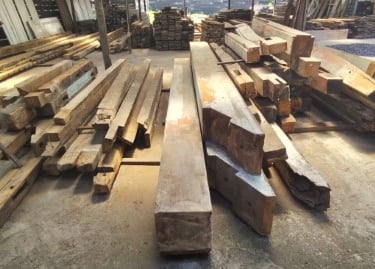Reclaimed Teak Wood: The Gold Standard for Luxury Flooring and Decking in Bali’s Tropical Climate
Reclaimed teak wood combines timeless beauty, unparalleled durability, and eco-friendly value, making it the top choice for luxury flooring and decking in Bali. Resistant to termites, humidity, and tropical weather, it delivers warmth, character, and authenticity unmatched by other hardwoods. Discover why reclaimed teak is the ultimate material for high-end projects.
9/22/20254 min read


Why Reclaimed Teak is the Material of Choice in Bali
Teak has always been regarded as one of the world’s most prestigious hardwoods. Known for its density, natural oils, and warm golden tone, teak is synonymous with durability and luxury. In Bali, reclaimed teak wood takes this reputation to the next level by offering both performance and sustainability.
Unlike new-growth teak, reclaimed teak comes from old houses, bridges, boats, and warehouses across Indonesia. This means the wood has already been seasoned for decades, making it incredibly stable and resistant to the environmental challenges of Bali’s tropical climate.
Organizations like the Forest Stewardship Council emphasize the importance of choosing reclaimed and certified wood as part of a sustainable building strategy. By selecting reclaimed teak, you are preserving forests while enjoying premium material quality.
Key Properties of Reclaimed Teak Wood
Reclaimed teak has physical and chemical properties that make it uniquely suited for flooring and decking in Bali:
Density and Strength: With a density of around 650–750 kg/m³, teak is hard enough to resist wear, while being workable for carpentry.
Moisture Resistance: Its tight grain structure makes it less prone to warping, swelling, or cracking in humid conditions.
Color and Patina: A rich golden-brown that matures into a silver-gray patina outdoors, creating an elegant aged look.
Low Maintenance: Requires minimal sealing or finishing compared to other hardwoods.
These qualities make reclaimed teak a clear winner for tropical projects where longevity and aesthetics are equally important.
Why Choose Reclaimed Over New Teak?
There are several compelling reasons why reclaimed teak is superior to newly harvested teak:
Stability – Older wood has gone through decades of expansion and contraction cycles, so it no longer warps or shrinks.
Hardness – Reclaimed teak often comes from old-growth trees, which are denser and stronger than plantation-grown teak.
Sustainability – Reclaimed wood reduces the demand for logging and supports the principles of circular economy.
Unique Character – Every piece carries a history, with visible nail holes, weathered textures, and aged patina that new teak cannot replicate.
Cost Efficiency – While premium, reclaimed teak often proves more affordable than sourcing certified new teak.
As highlighted by ArchDaily, reclaimed wood adds authenticity and a story to modern design, something increasingly valued in architecture today.
Reclaimed Teak for Luxury Flooring
Indoor flooring in Bali’s villas and resorts must balance elegance with durability. Reclaimed teak excels in both areas.
Smooth finish: Sanded and polished, reclaimed teak provides a refined surface perfect for high-end interiors.
Color richness: Its warm tones create a cozy, inviting atmosphere while maintaining sophistication.
Resilience: Resistant to scratches and dents, making it ideal for high-traffic areas like lobbies or living rooms.
Compatibility: Works beautifully with stone, glass, and tropical architectural features.
Teak flooring ages gracefully, developing character over time without losing its structural integrity.
Reclaimed Teak Decking: Perfect for Bali’s Outdoors
Outdoor environments in Bali expose materials to relentless humidity, salt air, heavy rain, and intense sunlight. Few woods can handle these conditions as well as teak.
Reclaimed teak decking provides:
Superior weather resistance: Natural oils protect against rot and fungus.
Slip resistance: The grain offers grip even in wet conditions.
Low upkeep: Requires only occasional oiling or sealing.
Hotels, restaurants, and luxury villas across Bali increasingly choose reclaimed teak decking to achieve both beauty and performance in tropical landscaping.
Cost Advantage of Reclaimed Teak Compared to Other Hardwoods
While teak has a reputation for being expensive, reclaimed teak is surprisingly cost-effective compared to other premium hardwoods.
Bangkirai: Strong but less stable than teak, requiring more maintenance.
Meranti: More affordable but not as durable in outdoor use.
Ulin (Ironwood): Extremely durable but often more costly and harder to source sustainably.
Reclaimed teak offers the perfect balance of price, performance, and prestige. Its long lifespan makes it a better investment than cheaper hardwoods that need frequent replacement.
Design Flexibility: Flooring, Decking, and Beyond
Reclaimed teak is not limited to flooring and decking. Its adaptability allows it to be used in a variety of applications:
Kisi-kisi (wooden screens) for natural ventilation and shading.
Staircases and railings, combining elegance with strength.
Furniture and cabinetry, showcasing the beauty of aged teak indoors.
Accent walls and cladding, adding warmth and texture to interiors.
This versatility makes reclaimed teak a favorite for architects and interior designers seeking continuity of material throughout a project.
Maintenance Tips for Reclaimed Teak in Bali
To maximize the lifespan of reclaimed teak installations, a few simple practices are recommended:
Regular Cleaning: Sweep or wash with mild soap and water to remove dust and salt residue.
Oil Treatments: Use natural oils to refresh color and protect surface fibers.
Sealing: For decking in high-exposure areas, apply marine-grade sealants to extend life.
Inspection: Check annually for loose fasteners or joints, particularly outdoors.
With minimal care, reclaimed teak can last 50 years or more, even in tropical climates.
The Sustainability Impact of Choosing Reclaimed Teak
Opting for reclaimed teak is not only a design choice but also an environmental statement. It helps reduce deforestation, supports responsible reuse of existing resources, and aligns with green building certifications.
As the U.S. Green Building Council points out, sustainable materials are increasingly in demand for eco-certified resorts and villas. Using reclaimed teak can contribute points toward LEED certification and enhance the eco-credentials of a project.
Kitaru Lumberyard Bali: Your Source for Premium Reclaimed Teak
At Kitaru Lumberyard Bali, we specialize in sourcing, preparing, and supplying high-quality reclaimed teak wood for flooring, decking, posts, and custom projects.
What sets us apart:
Careful selection of aged teak from reliable sources.
Precision milling to ensure stability and uniformity.
Expertise in tropical hardwoods and installation advice.
Commitment to sustainability and fair pricing.
By choosing Kitaru, you’re not just buying wood—you’re investing in authenticity, heritage, and long-term value.
Conclusion: Reclaimed Teak as the Ultimate Choice for Bali
When it comes to luxury construction in Bali, no material matches the prestige, durability, and sustainability of reclaimed teak wood. From flooring to decking, reclaimed teak delivers unmatched performance while telling a story of history and tradition.
For architects, designers, and homeowners seeking the perfect balance of beauty and strength, reclaimed teak is the gold standard.
📌 Ready to bring reclaimed teak into your next project?
Visit the Showroom
Jl. Pantai Saba No.47509, Saba, Kec. Blahbatuh, Kabupaten Gianyar, Bali 80581
Contact Us
Via the Contact page
By email:
info@kitaru-lumberyard-bali.com
By phone:
+62 0853 3375 1696 (WA)
Showroom Hours:
Mon to Fri: 8.30AM – 4.30PM
Sat: 8.30AM – 12 noon
(closed Sundays)
Copyright© 2024-2025 PT-PMA BNM Management Solutions. All rights reserved.
Trusted source for sustainable hardwood and quality hardware. We offer reclaimed Bangkirai, Meranti, Teak, and Kapur, plus exclusive decorative pieces in reclaimed Ulin from our partners. Supplying top-tier decking, flooring, and more—get the best quality at the best price.
